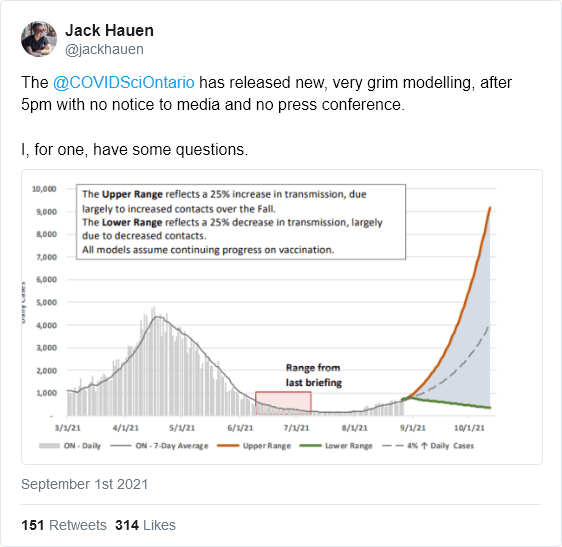In the very last “Weekly Dispatch” from The Line that I’ll be able to read and share (because those posts are going behind the paywall from next week onward), the difficulty in “trusting the science” is made very clear indeed:
A friend of The Line who lives in Ontario sent us a delightfully snippy little text this week attached to the Ontario Science Table’s latest COVID-19 modelling efforts.
“Do you have any idea what would happen if I walked into a meeting with a range from 500-9000, and expected people to take me seriously?” she wrote. “I want to believe you scientists, but you are making it impossible to have any faith in your work.”
She’s right. A range this wide is both useless and unfalsifiable. No government can look at this graph and decide what the best course of action ought to be, and no individual can look at this data and make reasonable decisions about how to go about his or her life. If you want to see catastrophic health-care collapse, it’s there at the top end, and if you want to see “pandemic is over” signal, it’s there near the bottom.
The Science Table might as well just put a giant ¯\_(ツ)_/¯ on the x/y axis and call it in. These guys have no goddamn clue what is going to happen, and they’d be better off just admitting as much.
The Public Health Agency of Canada’s modelling was equally pointless. It’s predicting another literal off-the-chart case spike by October; 15,000 cases per day, which is almost a third higher than the peak daily case rate of the second wave. Somehow, this will happen despite the fact that more than 70 per cent of the eligible population is now fully vaccinated.
We at The Line are looking forward to October. The fall will bring with crunchy leaves, warm lattes, and the ability to compare these models to reality; but in the meantime, we have to ask, what the hell is the purpose of these things?
If public-health types are trying to scare people into getting vaccinated and maintaining distance, we’re sorry to break this to you, but that’s not going to work anymore. Those who can be scared into changing their behaviour have done so already. And those who refuse to be scared are going to look at another set of unfalsifiable modelling predictions and roll their eyes.
We cannot say this enough: COVID-19 is now an endemic disease. We’re stuck with it. It’s not going away. We are going to experience another wave of cases. Hospitalizations and ICU admissions will rise. Our mortality rate will also increase — although these latter metrics will rise at nowhere near the rate as previous waves thanks to vaccines. Delta will pass. Then another variant will pop up. And another after that. We can’t let ourselves be trapped on a Ferris wheel of restrictions and easing every time case numbers go up and down for a disease that may be with us for years. Eventually, we have to make our peace with the suck, return to some semblance of normal, and figure out how to live our lives in a sustainable and healthy way — albeit with this new way to get sick and die in them.
We have an 83 per cent first-dose vaccination rate among those who are eligible; vaccine mandates, passports, $100 gift cards, may, at best, add a few points to that total. We have reached the point where we are grasping at increasingly divisive policies to make ever more incremental gains — in short, the law of diminishing returns is beginning to kick in, as it always does. If our current vaccination, mortality, and hospitalization rates are is not good enough to call time on this pandemic then what, exactly, is the exit strategy? And just from a pure communications perspective, how does releasing another round of bonkers off-the-charts modelling serve that end?




